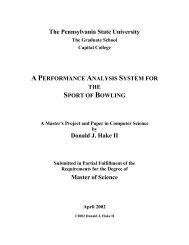k-Nearest Neighbor Classification on Spatial Data Streams Using P ...
k-Nearest Neighbor Classification on Spatial Data Streams Using P ...
k-Nearest Neighbor Classification on Spatial Data Streams Using P ...
You also want an ePaper? Increase the reach of your titles
YUMPU automatically turns print PDFs into web optimized ePapers that Google loves.
neighborhood area until there are k pixels in the neighborhood set. The expansi<strong>on</strong> is<br />
d<strong>on</strong>e in such a way that the neighborhood always c<strong>on</strong>tains the closest or most similar<br />
pixels of the target sample. The different expansi<strong>on</strong> mechanisms implement different<br />
distance functi<strong>on</strong>s. In the next secti<strong>on</strong> (secti<strong>on</strong> 3.1) we described the distance metrics<br />
and expansi<strong>on</strong> mechanisms.<br />
Of course, there may be more boundary neighbors equidistant from the sample than<br />
are necessary to complete the k nearest neighbor set, in which case, <strong>on</strong>e can either use<br />
the larger set or arbitrarily ignore some of them. To find the exact k nearest neighbors<br />
<strong>on</strong>e has to arbitrarily ignore some of them.<br />
T<br />
Fig. 3. T, the pixel in the center is the target pixels. With k = 3, to find the third nearest<br />
neighbor, we have four pixels (<strong>on</strong> the boundary line of the neighborhood) which are equidistant<br />
from the target.<br />
Instead we propose a new approach of building nearest neighbor (NN) set, where<br />
we take the closure of the k-NN set, that is, we include all of the boundary neighbors<br />
and we call it the closed-KNN set. Obviously closed-KNN is a superset of KNN set. In<br />
the above example, with k = 3, KNN includes the two points inside the circle and any<br />
<strong>on</strong>e point <strong>on</strong> the boundary. The closed-KNN includes the two points in side the circle<br />
and all of the four boundary points. The inductive definiti<strong>on</strong> of the closed-KNN set is<br />
given below.<br />
Definiti<strong>on</strong> 1. a) If x ∈ KNN, then x ∈ closed-KNN<br />
b) If x ∈ closed-KNN and d(T,y) ≤ d(T,x), then y ∈ closed-KNN<br />
where, d(T,x) is the distance of x from target T.<br />
c) Closed-KNN does not c<strong>on</strong>tain any pixel, which cannot be produced<br />
by steps a and b.<br />
Our experimental results show closed-KNN yields higher classificati<strong>on</strong> accuracy<br />
than KNN does. The reas<strong>on</strong> is if for some target there are many pixels <strong>on</strong> the<br />
boundary, they have more influence <strong>on</strong> the target pixel. While all of them are in the<br />
nearest neighborhood area, inclusi<strong>on</strong> of <strong>on</strong>e or two of them does not provide the<br />
necessary weight in the voting mechanism. One may argue that then why d<strong>on</strong>’t we use<br />
a higher k? For example using k = 5 instead of k = 3. The answer is if there are too<br />
few points (for example <strong>on</strong>ly <strong>on</strong>e or two points) <strong>on</strong> the boundary to make k neighbors<br />
in the neighborhood, we have to expand neighborhood and include some not so<br />
similar points which will decrease the classificati<strong>on</strong> accuracy. We c<strong>on</strong>struct closed-<br />
KNN <strong>on</strong>ly by including those pixels, which are in as same distance as some other<br />
pixels in the neighborhood without further expanding the neighborhood. To perform
















